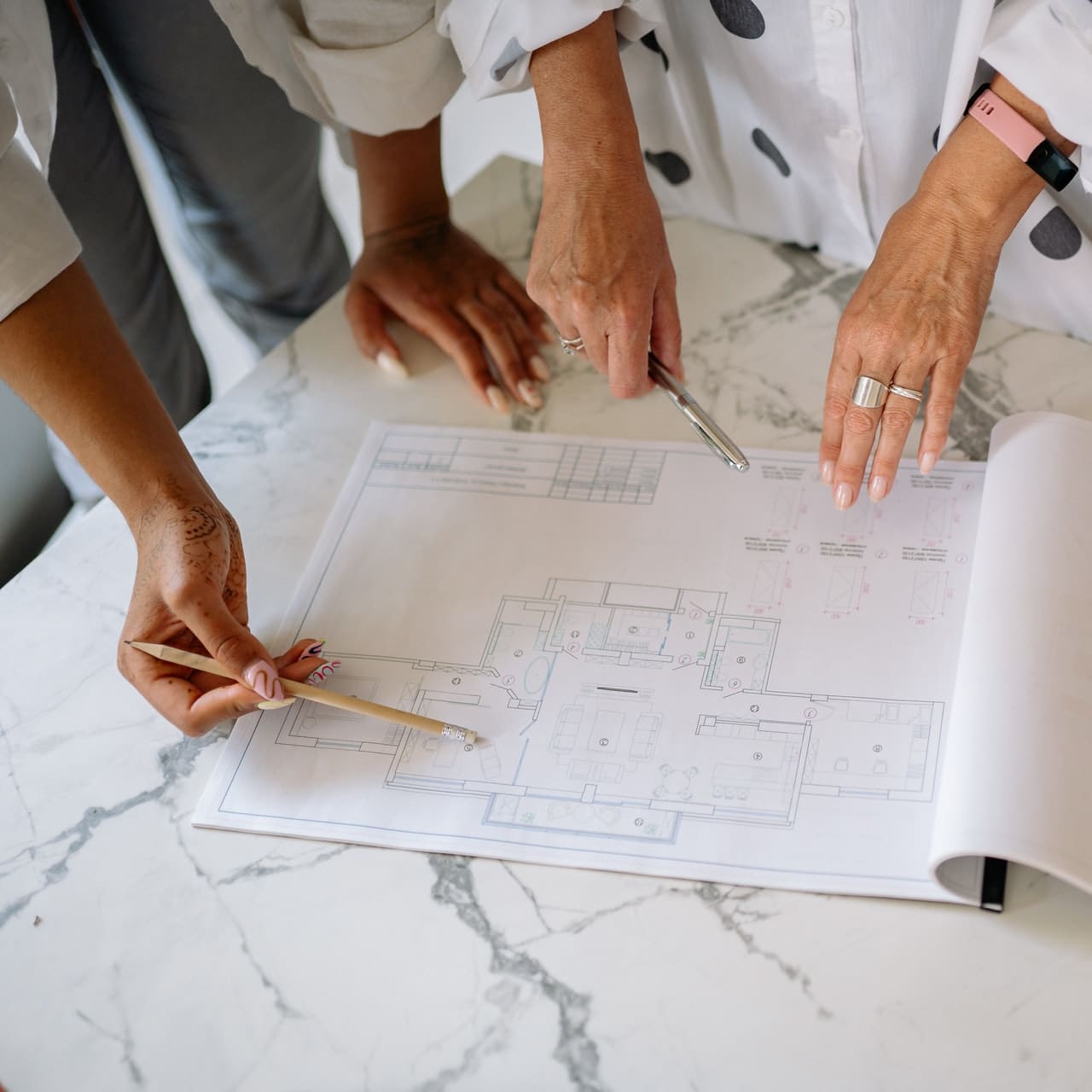Measuring your kitchen
A step-by-step guide
In this journey, where you will get the kitchen of your dreams, we help you with how to start from the very beginning and what you need to do. Jot these down, and then meet with designers to create your detailed 3D design.
How to measure your space

1. Draw an outline
Draw a rough layout of your kitchen, as seen from above. It doesn’t need to be perfect; it’s just to give your designer a basic idea to start creating your design. Use any plain paper you may have.
2. Add the details
Mark up any details we’ll need to know about on your drawing. Have a good look around your kitchen and note features like doors, windows, boilers, soil pipes, electrical meters, light switches, and any fixed plumbing so we can design your kitchen around them.


3. Start measuring
Divide your drawing into different key areas. Use a tape measure and write down each measurement. Don’t worry if it’s not perfect; we can do a more thorough size later if needed. And do not forget to take the height of your ceiling or drop-down ceiling if your space has one.
We offer a free home survey service. This is where your Bienal Cabinets designer will come and double-check your measurements before we begin assembling your kitchen.

Download grid paper
Download and print your grid paper to create a drawing of your current kitchen space. If you don't have access to a printer, you can use any plain paper you have at home instead.

Our top tips
Double-check your measurements when you're done, and remember to include any permanent fixtures like beams. Also, don't miss the features such as doors, windows, boilers, soil pipes, electrical meters, light switches, and any fixed plumbing.

Free kitchen design service
Visit our authorized stores and see our samples to get information by meeting face to face with our authorized sales representative.
Make an appointment for a virtual meeting and design together with our designers online.
After the process you will be able to get 3D visuals, detailed drawings and a quote.
Save, view and confirm your design and quote online in your CRM account.
Find out more

Our story
With our expertise of more than 50 years, transforming the project of your dreams into reality is not only a job for us. It is a passion project that comes straight from our hearts.

Our services
Quality is our priority. The services we offer and the quality of Bienal Cabinets are constantly advancing with the developing technology.

Our kitchens
Our timeless and passionate kitchens will lead you on the way to the design you desire
Frequently Asked Questions
How do I measure my kitchen?
Measuring your kitchen is an important part of any remodeling project. You want to make sure that the space you are working with has enough room for all the features you plan to include. Fortunately, measuring a kitchen is not difficult – it just requires some time and patience.
The first step in measuring your kitchen is determining what type of measurements you need. It’s best to start by measuring the overall size of the existing layout and then breaking it down into smaller sections such as walls, windows, and doors. This will give you a better sense of how much space there is in each area so that you can plan accordingly when designing your new kitchen layout.
Once those basic measurements are taken, move onto other areas like countertops, islands, appliances, cabinets, and even wall hangings or decorations. It’s especially important to ensure that larger items like refrigerators have plenty of clearance so they don’t block doorways or impede traffic flow through the room.
Finally, after obtaining all relevant measurements take them back to your design team so they can use this information while creating a digital visualization of what your final product might look like when complete! Doing this ahead of time will save money during construction by ensuring everything fits perfectly while avoiding costly mistakes due to incorrect dimensions being used during planning stages prior to purchasing materials or starting construction work on-site.
What is the standard measurement of a kitchen?
The standard measurements of a kitchen depend on several factors, including the size and layout of the room, the number of appliances and storage units going into it, and how much space you want between counters.
Generally speaking, a full-sized kitchen should have 12 feet by 10–12 feet of clear floor space. This gives enough space to walk around comfortably while still allowing plenty of countertop work surfaces to lay out ingredients or equipment. If you plan to include an island in your kitchen design, then aim for 14–16 feet by 12 feet as a minimum size.
You will also need enough width for all your appliances together so that you can open their doors without bumping into anything else: at least 120 inches (10 ft) is recommended in an L-shaped or one wall kitchen layout; more if other designs are involved. Each appliance should have about 15 inches (1 ft 3in) distance from its neighbor as well as 24–30 inches behind it for maneuverability when accessing cabinets and drawers below.
Finally, try adding 36–42 inches from each end wall side down the length of each workspace countertop surface; this will provide ample room to move around while prepping food items during meal preps!
How is a 10x10 kitchen measured?
A 10×10 kitchen is generally considered a small kitchen, and can often be found in apartments or condos. The measurements of a 10×10 kitchen typically refer to the overall square footage that the space offers. This means that if you measure the length and width of your kitchen combined, they should total around 100 square feet (or 10×10).
For example, if your room is 8 feet wide by 12 feet long, then it would technically fall into this category as 96 square feet is very close to 100. However, kitchens aren’t always perfect squares so talking to contractors or designers may be necessary when trying to determine exactly what kind of space you’re dealing with.
When it comes to designing a 10×10 kitchen most options include standard appliances like those found in most homes including an oven/stovetop combo unit (commonly 24 inches wide), refrigerator (commonly 30-36 inches wide), microwave above-range (17-22 inches wide) plus cabinet and counter top space for food prep such as chopping boards or blenders etc. A lot will depend on how much storage you need but with careful design thought even a small footprint like this can have everything needed for ample meal preparation and enjoyment!
What is the most accurate way to measure in a kitchen?
The most accurate way to measure in a kitchen is to use a digital scale. Digital scales are designed to provide precise measurements of both dry and wet ingredients, making them essential for cooking and baking measurements. A digital scale can be used to more accurately measure ingredients like herbs, spices, nuts, oils and other small items that may not be feasible with traditional measuring cups and spoons. They also serve as excellent time-savers when multiple ingredients must be quickly weighed at once. Furthermore, they are accurate up to one gram or 0.1 ounce (depending on the type of weighing unit you choose). This accuracy makes them invaluable for those who need an exact amount for professional cooking or baking recipes — after all, the recipe’s success depends on it!
How many m2 is an average kitchen?
The average size of a kitchen varies significantly based on the geographic location, the age and size of the house and other factors. Generally, an average sized single-family home in North America will have a kitchen that is 10 to 15 square meters (m2). However, in Europe, where living spaces are typically more compact due to centuries-old construction styles, kitchens may be as small as 5–7 m2 for a one-room studio apartment.
In recent years there has been an increase in demand for larger kitchens due to modern cooking trends such as; gourmet dishes often requiring multiple appliances and tools or meal prepping which requires additional storage space. As such, many new builds or recently renovated kitchens tend to range from 12–20 m2 depending on the type of cuisine prepared by occupants. For example if you’re frequently preparing elaborate Banquet meals then you may require up to 30 m2 in order to accommodate all your desired appliances and storage space comfortably!
How do I calculate my kitchen floor?
Calculating the size of your kitchen floor is a relatively simple process that involves measuring the length, width, and any other areas you plan to include.
To begin, it is important to measure from wall-to-wall in both the length and width of your kitchen. Measurements should be taken at least three times for accuracy and should include all areas you plan to cover with flooring material such as built-in cabinets, closets, islands or breakfast bars. Once you have established the outlines of your kitchen space add up all measurements to get a total square footage for each wall. Multiply this number by two in order to find total square footage (length x width) for entire room.
You may also need to consider doorways or openings leading out of your kitchen when calculating size of space needed for new flooring material. For example if there is an archway between the hallway and kitchen you will need to measure across both spaces at their widest point before adding them together in order calculate overall area covered by flooring material. It is also recommended that when purchasing materials account an additional 5%-10% overage rate ensure enough materials are on hand during installation processes so as not run into shortages due unexpected cuts or irregularities present within floorspace itself.
Finally always remember certain types and styles of tiles or woodwork (such as parquet blocks) may require special cutting tools which can increase risk of mistakes being made during installation; thus it is suggested that homeowners seek professional assistance whenever possible so as best protect their investments from unnoticed mistakes often difficult rectify after completion phase has been reached!
